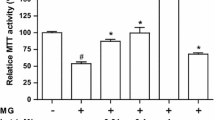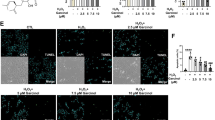Abstract
Diabetic bone disease is associated with increased oxidative damage and 2-deoxy-d-ribose (dRib) is used to induce oxidative damage similar to that observed in diabetics. To determine if hesperetin (3′,5,7-trihydroxy-4-methoxyflavanone) could influence osteoblast dysfunction induced by dRib, osteoblastic MC3T3-E1 cells were treated with dRib and hesperetin. Then, markers of osteoblast function and oxidative damage were examined. Hesperetin (10−7–10−5 M) caused a significant elevation of alkaline phosphatase (ALP) activity, collagen content, and total antioxidant potential of MC3T3-E1 cells in the presence of 20 mM dRib (p < 0.05). Moreover, hesperetin (10−7 M) decreased cellular protein carbonyl (PCO), advanced oxidation protein products (AOPP), and malondialdehyde (MDA) contents of osteoblastic MC3T3-E1 cells in the presence of 20 mM dRib. These results demonstrate that hesperetin attenuates dRib-induced damage, suggesting that hesperetin may be a useful dietary supplement for minimizing oxidative injury in diabetes related bone diseases.






Similar content being viewed by others
References
Ayrton A, Morgan P. Role of transport proteins in drug absorption, distribution and excretion. Xenobiotica. 2001;31:469–97.
Balint E, Szabo P, Marshall CF, Sprague SM. Glucose-induced inhibition of in vitro bone mineralization. Bone (NY). 2001;28:21–8.
Baynes JW, Thorpe SR. Role of oxidative stress in diabetic complications. A new perspective on an old paradigm. Diabetes. 1999;48:1–9.
Bradford MM. A rapid and sensitive method for the quantitation of microgram quantities of protein utilizing the principle of protein-dye binding. Analytical Biochemistry. 1976;72:248–54.
Bunn HF, Higgins PJ. Reaction of monosaccharides with proteins: possible evolutionary significance. Science. 1981;213:222–4.
Clarkson MR, Murphy M, Gupta S, Lambe T, Mackenzie HS, Godson C, Martin F, Brady HR. High glucose-altered gene expression in mesangial cells. Actin-regulatory protein gene expression is triggered by oxidative stress and cytoskeletal disassembly. J Biol Chem. 2002;277:9707–12.
Crespy V, Morand C, Besson C, Cotelle N, Vezin H, Demigne C, et al. The splanchnic metabolism of flavonoids highly differed according to the nature of the compound. Am J Physiol Gastrointest Liver Physiol. 2003;284:G980–8.
Domon S, Shimokawa H, Yamaguchi S, Kunimichi S. Temporal and spatial mRNA expression of bone sialoprotein and type I collagen during rodent tooth movement. Eur J Orthod. 2001;23:339–48.
Evans JL, Goldfine ID, Maddux BA, Grodsky GM. Oxidative stress and stress-activated signaling pathways: a unifying hypothesis of type 2 diabetes. Endocr Rev. 2002;23:599–622.
Horcajada-Molteni M, Chanteranne B, Lebecque P, Davicco MJ, Coxam V, Young A, et al. Amylin and bone metabolism in streptozotocin-induced diabetic rats. J Bone Miner Res. 2001;16:958–65.
Hunt JV, Dean RT, Wolff SP. Hydroxyl radical production and autoxidative glycosylation. Glucose autoxidation as the cause of protein damage in the experimental glycation model of diabetes mellitus and ageing. Biochem J. 1988;256:205–12.
Ihara Y, Toyokuni S, Uchida K, Odaka H, Tanaka T, Ikeda H, et al. Hyperglycemia causes oxidative stress in pancreatic beta-cells of GK rats, a model of type 2 diabetes. Diabetes. 1999;48:927–32.
Kanno S, Anuradha CD, Hirano S. Localization of zinc after in vitro mineralization in osteoblastic cells. Biol Trace Elem Res. 2001;83:39–47.
Kletsas D, Barbieri D, Stathakos D, Botti B, Bergamini S, Tomasi A, Monti D, et al. The highly reducing sugar 2-deoxy-d-ribose induces apoptosis in human fibroblasts by reduced glutathione depletion and cytoskeletal disruption. Biochem Biophys Res Commun. 1998;243:416–25.
Koh G, Suh KS, Chon S, Oh S, Woo JT, Kim SW, et al. Elevated cAMP level attenuates 2-deoxy-d-ribose-induced oxidative damage in pancreatic β-cells. Arch Biochem Biophys. 2005;438:70–9.
Levine RL. Carbonyl modified proteins in cellular regulation, aging, and disease. Free Radic Biol Med. 2002;32:790–6.
Lien YH, Stern R, Fu CCC, Siegel RC. Inhibition of collagen fibril formation in vitro and subsequent cross-linking by glucose. Science. 1984;255:1489–91.
Lowry OH, Roberts NR, Wu M-L, Hixon WS, Crawford EJ. The quantitative histochemistry of brain. II. Enzyme measurements. J Biol Chem. 1954;207:19–37.
Matsuoka T, Kajimoto Y, Watada H, Kaneto H, Kishimoto M, Umayahara Y, et al. Glycation-dependent, reactive oxygen species-mediated suppression of the insulin gene promoter activity in HIT cells. J Clin Invest. 1997;99:144–50.
Monnier VM. Nonenzymatic glycosylation, the Maillard reaction and the aging process. J Gerontol. 1990;45:B105–18.
Narisawa S, Frohlander N, Millan JL. Inactivation of two mouse alkaline phosphatase genes and establishment of a model of infantile hypophosphatasia. Dev Dyn. 1997;208:432–46.
Noda M. Current topics in pharmacological research on bone metabolism: regulation of bone mass by the function of endogenous modulators of bone morphogenetic protein in adult stage. J Pharmacol Sci. 2006;100:211–4.
Ozgocmen S, Kaya H, Fadillioglu E, Aydogan R, Yilmaz Z. Role of antioxidant systems, lipid peroxidation, and nitric oxide in postmenopausal osteoporosis. Mol Cell Biochem. 2007;295:45–52.
Robertson RP, Olson LK, Zhang HJ. Differentiating glucose toxicity from glucose desensitization: a new message from the insulin gene. Diabetes. 1994;43:1085–9.
Robertson RP, Tsai P, Little SA, Zhang HJ, Walseth TF. Receptor-mediated adenylate cyclase-coupled mechanism for PGE2 inhibition of insulin secretion in HIT cells. Diabetes. 1987;36:1047–53.
Seeman E. Reduced bone formation and increased bone resorption: rational targets for the treatment of osteoporosis. Osteoporos Int. 2003;14 (Suppl. 3):S2–8.
Silberberg M, Morand C, Mathevon T, Besson C, Manach C, Scalbert A, et al. The bioavailability of polyphenols is highly governed by the capacity of the intestine and of the liver to secrete conjugated metabolites. Eur J Nutr. 2006;45(2):88–96.
Stein GS, Lian JB, Owen TA. Relationship of cell growth to the regulation of tissue-specific gene expression during progressive osteoblast differentiation. The FASEB Journal. 1990;4:111–23.
Terada M, Inaba M, Yano Y, Hasuma T, Nishizawa Y, Morii H, et al. Growth-inhibitory effect of a high glucose concentration on osteoblast-like cells. Bone. 1998;22:17–23.
Vissers MC, Winterbourn CC. Oxidative damage to fibronectin. I. The effects of the neutrophil myeloperoxidase system and HOCl. Arch Biochem Biophys. 1991;285:53–9.
Witko-Sarsat V, Friedlander M, Capeillere-Blandin C, Nguyen-Khoa T, Nguyen AT, Zingraff J. Advanced oxidation protein products as a novel marker of oxidative stress in uremia. Kidney Int. 1996;49:1304–13.
Wolff SP, Dean RT. Glucose autoxidation and protein modification. The potential role of ‘autoxidative glycosylation’ in diabetes. Biochem J. 1987;245:243–50.
Acknowledgements
The Korea Research Foundation Grant funded by Korean Government (MOEHRD; KRF-2005-F00085) supported this work.
Author information
Authors and Affiliations
Corresponding author
Rights and permissions
About this article
Cite this article
Choi, E.M., Kim, Y.H. Hesperetin attenuates the highly reducing sugar-triggered inhibition of osteoblast differentiation. Cell Biol Toxicol 24, 225–231 (2008). https://doi.org/10.1007/s10565-007-9031-0
Received:
Accepted:
Published:
Issue Date:
DOI: https://doi.org/10.1007/s10565-007-9031-0




